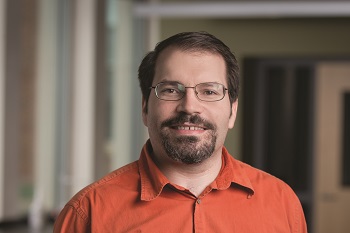Rawlings, students come closer to understanding how to fight infectious disease
Rawlings and 11 undergraduate researchers have invested eight years in attempting to better understand the mechanism that triggers an immune system response to dangerous intruders.
In the battle against cancer and infectious diseases, the immune system’s T lymphocytes (T cells) are like heat-seeking missiles that target and obliterate invading pathogens. But sometimes those same disease-fighting cells wreak havoc on the body.

Associate Professor of Biology Jason Rawlings
“Control of T cell proliferation is absolutely essential,” said Furman Associate Professor of Biology Jason Rawlings ’96. “If it’s not controlled properly, catastrophic disease states can result. Uncontrolled proliferation leads to cancer. If the wrong T cells propagate, the result is autoimmunity. And if T cells fail to multiply altogether, the outcome is immunodeficiency.” Their research was published in Cellular Immunology.
T cells are activated and then multiply in the presence of pathogens, which is why lymph nodes swell when we get sick, said Rawlings. Through the complex nature of the adaptive immune system, activated T cells morph into specialized “effector cells” to better attack the specific threat at hand.
Controlling the propagation of disease-quashing cells is a growth factor called interleukin 2 (IL-2). In previous research published in Molecular Immunology (2015), Rawlings and his students showed that the physical compaction of DNA within the nucleus determines if a lymphocyte will respond to IL-2.
Rawlings says to think of naive T cells (those that have not been exposed to pathogen) as having tightly wound DNA, like a ball of yarn. “When T cells are exposed to pathogen, the DNA unwinds, which permits the cell to respond to IL-2 by allowing transcription factors to bind to the unwound DNA – a process that leads to the expression of genes required for proliferation,” he said. In their most recent paper, they show how a pathogen triggers this reconfiguration that makes the cell competent to respond to IL-2.
“The significance of the work is that it not only provides a new understanding of how the immune system works in the context of fighting infection, it sheds light on why immune cells might proliferate when they are not supposed to, for example, in the context of leukemias, lymphomas and in certain autoimmune diseases,” he said. “So, understanding the mechanism that controls proliferation of T cells could lead to novel approaches in treating all these disease states.”
Furthermore, the recent reporting that COVID-19 immunity may be mediated by T cells makes the work by the students in the Rawlings Lab all the more impactful.
“Understanding how T cells gain the competence to respond to pathogens, like SARS-CoV2, may help us learn how to develop therapeutics to aid in treating COVID-19,” Rawlings said.
Going forward, he says this study will inform future projects in the Department of Biology to determine if the mechanism that controls T cell proliferation can be applied to other cells of the immune system.